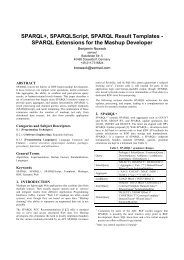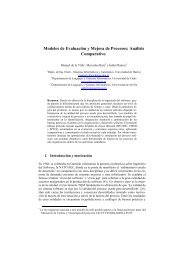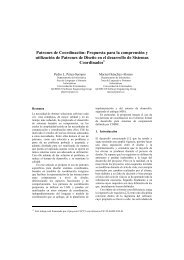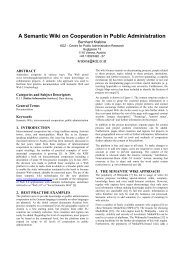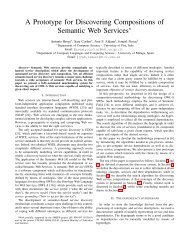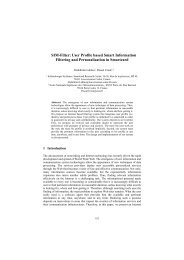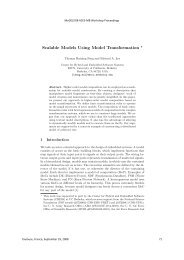ontology-based information extraction systems (obies 2008)
ontology-based information extraction systems (obies 2008)
ontology-based information extraction systems (obies 2008)
You also want an ePaper? Increase the reach of your titles
YUMPU automatically turns print PDFs into web optimized ePapers that Google loves.
(HTML) and labels provided by external tools. Patterns may be inlined in the <strong>extraction</strong><br />
<strong>ontology</strong> or sourced from (possibly large) external files, and may include e.g. fixed lexical<br />
tokens, token wildcards, character-level regexps, formatting tags, labels representing<br />
the output of external NLP tools or references to other patterns or attribute candidates.<br />
For numeric types, default value patterns for integer/float numbers are provided.<br />
For both attribute and class definitions, axioms can be specified that impose constraints<br />
on attribute value(s). For a single attribute, the axiom checks the to-be-extracted<br />
value and is either satisfied or not (which may boost or suppress the attribute candidate’s<br />
score). For a class, each axiom may refer to all attribute values present in the partially<br />
or fully parsed instance. For example, a start time of a seminar must be before the end<br />
time. Arbitrarily complex axioms can be authored using JavaScript. Further attributelevel<br />
evidence includes formatting constraints (such as not allowing the attribute value<br />
to cross an HTML element) and coreference resolution scripts.<br />
Each class definition enumerates the attributes which may belong to it, and for each<br />
attribute it defines a cardinality range. Extraction knowledge may address both the content<br />
and the context of a class. Class content patterns are analogous to the attribute<br />
value patterns, however, they may match parts of an instance and must contain at least<br />
one reference to a member attribute. Class content patterns may be used e.g. to describe<br />
common wordings used between attributes or just to specify attribute ordering. For each<br />
attribute, the engagedness parameter may be specified to estimate the apriori probability<br />
of the attribute joining a class instance (as opposed to standalone occurrence). Regarding<br />
class context, analogous class context patterns and similar formatting constraints<br />
as for attributes are in effect.<br />
In addition, constraints can be specified that hold over the whole sequence of extracted<br />
objects. Currently supported are minimal and maximal instance counts to be<br />
extracted from a document for each class.<br />
All types of <strong>extraction</strong> knowledge mentioned above are pieces of evidence indicating<br />
the presence (or absence) of a certain attribute or class instance. Every piece of<br />
evidence may be equipped with two probability estimates: precision and recall. The precision<br />
of evidence states how probable it is for the predicted attribute or class instance<br />
to occur given the evidence holds, disregarding the truth values of other evidence. The<br />
recall of evidence states how abundant the evidence is among the predicted objects,<br />
disregarding whether other evidence holds.<br />
2.3 Example<br />
In order to illustrate most of the above features, we present and explain an example<br />
from the seminar announcement <strong>extraction</strong> task 3 , in which the speaker name, location<br />
and start and end times (stime, etime) are to be extracted. Fig. 1 shows the structure of<br />
an <strong>extraction</strong> <strong>ontology</strong> for this task. Fig. 2 displays a part of the corresponding code<br />
in the XML-<strong>based</strong> <strong>ontology</strong> definition language, dealing with the name of the speaker<br />
and start time. Note that the <strong>extraction</strong> <strong>ontology</strong> defines some extra attributes like date,<br />
host and submitter; these are ‘helper’ attributes extracted in order for the system not to<br />
confuse them with the remaining attributes.<br />
3 Compiled by A. McCallum,http://www.cs.umass.edu/˜mccallum/code-data.html.



